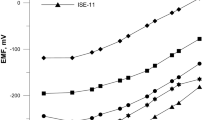Abstract
Metal complexes with a hydroxamic acid, namely, N-phenyl-N-(3-styrylacryloyl)hydroxylamine (PSAHA), are promising reagents for use in the preparation of cation- and anion-selective electrodes. The in situ formation of metal complexes by membrane conditioning in a solution of an appropriate metal salt made it possible to prepare cation-selective electrodes for methyl ester of phenylalanine (UO2+ 2) and anion-selective electrodes for tryptophan, phenylalanine (Sn(IV)), and aspartic acid (Cu(II)). The PSAHA-based membrane is sensitive to nitrate ions in solutions of uranyl nitrate (the metal complex is formed in the membrane even without special conditioning).
Similar content being viewed by others
REFERENCES
Pletnev, I.V. and Zolotov, Yu.A., Ion Exchange and Solvent Extraction, Marinsky, J. and Marcus, Y., Eds., New York: Marcel Dekker, 1997, vol. 13, p. 95.
Stainle, E., Shaller, U., and Meyerhoff, M.E., Anal. Sci., 1998, vol. 14, no. 1, p. 79.
Chaniotakis, N., Park, S., and Meyerhoff, M.E., Anal. Chem., 1989, vol. 61, no. 6, p. 566.
Park, S., Matuszewski, W., Meyerhoff, M.E., et al., Electroanalysis, 1991, vol. 3, no. 6, p. 909.
Li, J.Z., Hu, M., and Yu, R.Q., Huaxue Xuebao, 1995, vol. 53, no. 11, p. 1118.
Li, J., Pang, X., Gao, D., and Yu, R., Talanta, 1995, vol. 42, no. 11, p. 1775.
Leyzerovich, N.N., Shvedene, N.V., Blikova, Yu.N., et al., Electroanalysis, 2001, vol. 13, no. 3, p. 246.
Li, Z.Q., Song, X.P., Shen, G.L., and Yu, R.Q., Anal. Lett., 1998, vol. 31, no. 9, p. 1473.
Li, Z.Q., Ruo, Y., and Min, Y., Talanta, 1998, vol. 46, no. 5, p. 943.
Pilipenko, A.T. and Zul'figarov, O.S., Gidroksamovye kisloty (Hydroxamic Acids), Moscow: Nauka, 1989.
Shvedene, N.V., Leizerovich, N.N., Kostalyndina, E.V., et al., Vestn. Mosk. Univ., Ser. Khim., 2000, vol. 41, no. 1, p. 34.
Moody, G.J., Owusu, R.K., and Thomas, J.D.R., Analyst (Cambridge, U.K.), 1987, vol. 112, no. 2, p. 121.
Stamey, T.W. and Christian, R., Talanta, 1966, vol. 13, no. 1, p. 144.
IUPAC Stability Constants Database (SCDB, Academic Software, England), 1993, http://www.acadsoft.co.uk/scdbase/scdbase.htm.
Gallai, Z.A., Sheina, N.M., and Oliferenko, G.L., Zh. Anal. Khim., 1977, vol. 32, no. 9, p. 1722.
Author information
Authors and Affiliations
Rights and permissions
About this article
Cite this article
Berdnikova, L.P., Shvedene, N.V. & Pletnev, I.V. Hydroxamic Acids and Their Metal Complexes Obtained in situ as Electrode-Active Components in the Membranes of Ion-Selective Electrodes. Russian Journal of Coordination Chemistry 28, 816–821 (2002). https://doi.org/10.1023/A:1021119217663
Issue Date:
DOI: https://doi.org/10.1023/A:1021119217663



